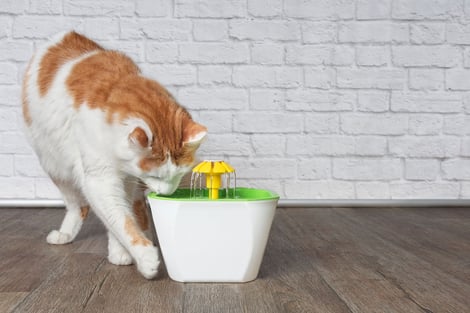
Pets need plenty of fresh water to stay hydrated and healthy. But what’s all the fuss about water fountains for pets? The market seems to be flooded (get it?) with ads for pet water fountains, and it can be challenging to sort out the claims.
Humans have coexisted with companion pets for millennia, and somehow they got enough water to survive.
Does Your Pet Need a Water Fountain?
Unless you or your veterinarian have noticed that your pet is not drinking enough water, you are probably safe using an old-fashioned bowl of water. Just be sure to change it out daily and keep the bowl clean.
This is doubly true if you are living on a tight budget. I know people prioritize their pets, but water fountains can be pricey, and in most cases, I don’t think it’s worth the money. Besides, you’d have to remember to change the filter every month, which adds to the cost of maintaining safe and clean water for your furry friend.
Most cats will drink enough water if you give them a wide, shallow stainless steel bowl that you can find at a pet store, big box store, or even a thrift store or garage sale. Dogs are not as picky about the bowl type, but it should also be stainless steel. Cats can get “whisker fatigue” if they have to use a deep bowl and put their face and whiskers into the bowl.
I notice my cat Pearl tends to drink a lot all at once, and then not much for a while. So don’t be alarmed if your pet seems to have this kind of drinking pattern.
Does the Water Bowl Material Matter?
Yes. Stainless steel is best because it doesn't tend to attract harmful germs like other materials can. Ceramic bowls are cheap, but they can crack, which can create places for nasty germs to take hold.
What If My Cat Isn’t Drinking Enough?
This article on preventing dehydration in cats reminds us how important drinking enough water is for cats. Water…
- flushes the kidneys and prevents kidney and bladder stones
- helps regulate their body temperatures
- helps them digest their food
- aids circulation
Dehydration is what happens when an animal doesn’t take in as many fluids as they lose. Their bodies get out of whack. Not drinking enough water is only one cause of dehydration. It can also be caused by diarrhea, vomiting, diabetes, heatstroke, or kidney or thyroid disease.
You should talk to your vet if you notice or suspect any of these more serious issues.
In the meantime, there are other things you can do to encourage more water drinking.
- Add a little flavor: tuna, salmon, or clam juice to their water bowl—but no more than a teaspoon a day.
- Add turkey or chicken broth (without onion or garlic) or bone broth to their water bowl.
- Switch some of their food from dry kibbles to canned food so they get more liquid that way. Note: switching food needs to happen gradually, or animals can get sick with a sudden change in diet.
If you do try the above, it becomes even more important that you change their water once a day and clean their bowl.
If none of that works and you still want to encourage your pet to drink more water, you can look into buying a fountain.
Moving the Water
Is your cat not interested in their bowl but drawn to the running water of your sink? That’s a possible sign that your cat might drink more if they had a water fountain.
Veterinarians have different points of view about water fountains. In this article comparing various water fountains for cats, veterinarian Jean Hofve says “Running water is especially enticing, and pet fountains are a great solution.”
But it’s not much of a solution if your cat isn’t interested. In that same article, the author set up a video camera to see if her kitty was drinking from the fountain. She was watching it, but preferred to drink out of her water bowl.
If You Are Determined…
People know their pets better than anyone else, so if you and your vet think your pet should try out a fountain—and you can afford it—do your homework. You’ll want to research the options because the cost of fountains varies from about $20 to more than $100.
This article in Pets.WebMD.com has tips for choosing a fountain and getting a cat used to it. The authors say that many cats are drawn to running water and think that standing water isn’t safe.
These experts suggest testing a fountain out before investing in one. Buying from a local pet store means you can talk to an actual human being instead of getting a sales pitch or talking to a bot.
- What happens when the fountain is low on water? Does it shut off? Or make loud sounds? (Cats will not like that.)
- Does it have a timer setting?
- Could the design harm your cat?
- Can your cat reach the water easily?
- Is the fountain easy to clean?
A Detailed Comparison
The New York Times’ Wirecutter column did a thorough job of comparing various water fountains, and even created a chart comparing how much it costs to run a fountain. Their research found that several fountains that worked well for cats weren’t big enough for multiple cats or for dogs.
Training Your Cat to Use a Fountain
Even though they might enjoy running water in your sink, most cats don’t like change. So if you add a fountain to your home, you’ll need to keep the water bowl where it is until you’re sure they are going to use the fountain.
The cat will want to sniff it to check it out. You can start by leaving it out without water, then fill it without turning it on, then switch it on.
Whatever you do, don’t rush the process. Your cat might take a while to get used to the look and sound of the fountain. And if you force it, they might reject it.
Placement Matters
Whether your cat is drinking from a fountain or a bowl might matter less than where the item is placed. If a cat’s bowl is in the corner, they might feel vulnerable, especially if there are other pets around, or anything else that makes them suspicious. The bowl or fountain should be somewhere where they can observe what is going on and make a quick escape if they feel the need.
What About Dogs?
Many of the articles out there focus on water fountains for cats. That might be because there is even less evidence that dogs need a drinking fountain.
The New York Times comparison found that several fountains made for big dogs were difficult to assemble and clean—so buyer beware!
Clean Water Is Important!
No matter what your pet is drinking out of, it’s important to keep it clean by running it through the dishwasher or hand washing it often (daily) to prevent mold and bacteria from building up.
If your dog or cat seems to be drinking too much or not enough, talk to your vet before spending money on an expensive fountain. It could be a health issue, and help is available for low-income pet parents who need assistance to cover the costs of veterinary care.

